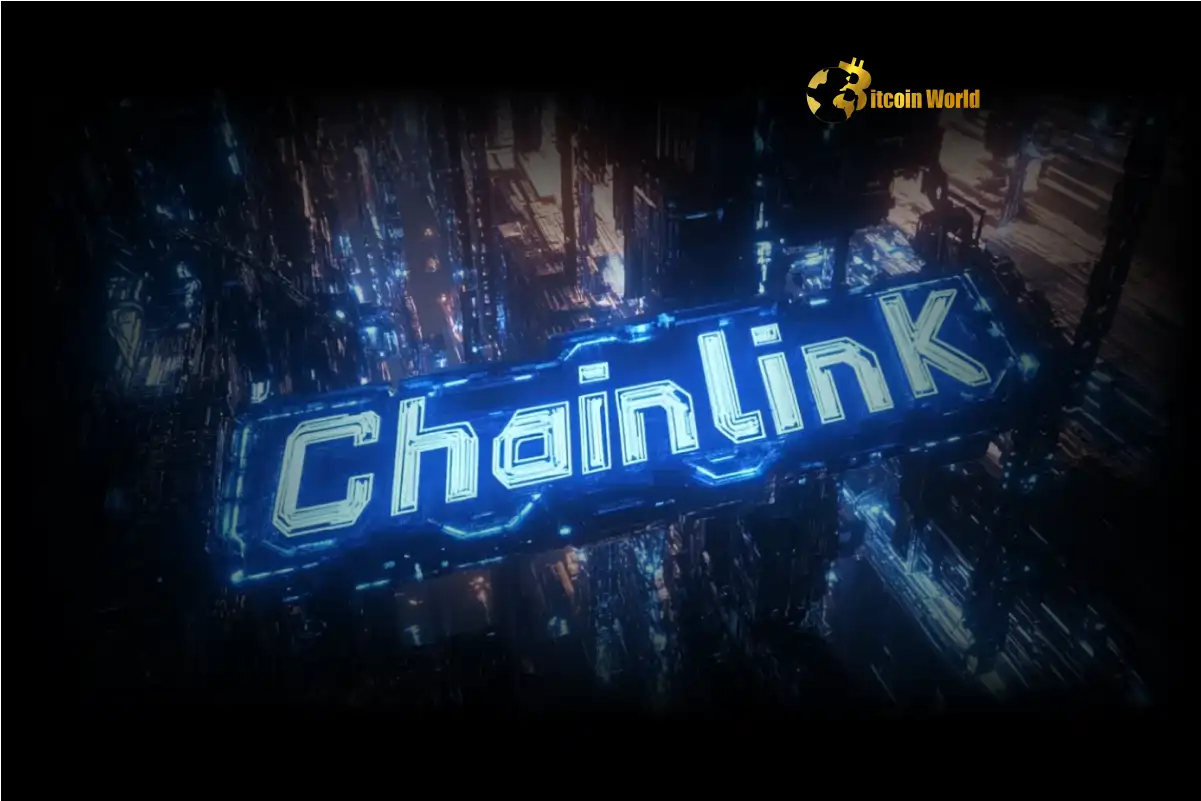Revolutionize Crypto Payments: Chainlink Unleashes ‘Payment Abstraction’ on Mainnet
0
0

Exciting news for the crypto world! Chainlink, a leading decentralized oracle network, has just dropped a game-changer: Payment Abstraction. Launched on the mainnet, this innovative system is poised to streamline how payments work within the expansive Chainlink Network. For anyone navigating the complexities of decentralized finance (DeFi) and cross-chain transactions, this development is a significant leap forward. Let’s dive into what Chainlink Payment Abstraction is all about and why it matters.
What is Chainlink Payment Abstraction and Why Should You Care?
Imagine a world where paying for services across different blockchain networks is as easy as using a single currency. That’s the promise of Chainlink Payment Abstraction. In essence, it’s a system designed to simplify the payment process within the Chainlink ecosystem. Instead of being restricted to using only LINK tokens for services, users now have the flexibility to pay using a variety of digital assets. This includes gas tokens, which are essential for transaction fees on blockchains, and stablecoins, cryptocurrencies designed to maintain a stable value.
This flexibility is crucial because:
- Reduces Friction: No more juggling multiple tokens just to interact with Chainlink services. Pay with what you have readily available.
- Enhances User Experience: Makes the Chainlink Network more accessible and user-friendly, especially for newcomers to the crypto space.
- Boosts Adoption: By simplifying payments, Chainlink is paving the way for wider adoption of its oracle services across various DeFi applications and beyond.
Think of it like using a universal adapter for your crypto payments. You’re no longer confined to a single plug type (token) but can use a variety of options to power your interactions within the Chainlink Network.
The Initial Focus: Streamlining DeFi Fee Management with SVR
Chainlink isn’t just throwing Payment Abstraction out into the wild without a specific purpose. The initial focus is laser-sharp: to revolutionize fee management for Decentralized Finance (DeFi) applications using Chainlink Smart Value Recapture (SVR).
Let’s break down what this means:
- Chainlink Smart Value Recapture (SVR): This is an oracle solution from Chainlink designed to help DeFi platforms recapture what’s known as non-toxic Maximal Extractable Value (MEV).
- Maximal Extractable Value (MEV): In simple terms, MEV refers to the profit that can be extracted by manipulating the order of transactions within a blockchain block. While some forms of MEV are considered beneficial (like arbitrage), “toxic” MEV can harm users.
- Chainlink Data Feeds: These are crucial for DeFi, providing real-world data (like price feeds) to smart contracts. SVR works in conjunction with these data feeds.
So, how does Payment Abstraction fit in? SVR generates fees as it helps DeFi apps recapture MEV. Previously, managing these fees might have involved complexities in terms of token types and payment processes. Now, with Payment Abstraction, converting these fees becomes significantly more streamlined. This means DeFi platforms leveraging Chainlink SVR can enjoy a more efficient and less cumbersome fee management system.
Benefits of Chainlink Payment Abstraction: A Deep Dive
The launch of Chainlink Payment Abstraction unlocks a plethora of benefits for various stakeholders within the crypto ecosystem. Let’s explore some of the key advantages in detail:
For DeFi Developers:
- Simplified Integration: Integrating Chainlink services into DeFi protocols becomes easier. Developers can focus on building innovative applications without getting bogged down in complex payment integrations.
- Reduced Operational Overhead: Managing payments in various tokens can be operationally intensive. Payment Abstraction significantly reduces this overhead, freeing up developer resources.
- Enhanced User Acquisition: By offering flexible payment options, DeFi platforms can attract a wider user base, including those who may not hold LINK tokens.
For Chainlink Network Users:
- Greater Flexibility: Users are no longer restricted to paying solely in LINK. They can utilize assets they already hold, making interactions with the Chainlink Network more convenient.
- Lower Barrier to Entry: The ability to pay with stablecoins or gas tokens lowers the barrier to entry for new users who might be hesitant to acquire LINK tokens initially.
- Improved Cost Efficiency: Depending on market conditions and token holdings, users might find it more cost-effective to pay with certain assets compared to others.
For the Chainlink Ecosystem as a Whole:
- Increased Network Utility: Payment Abstraction enhances the utility of the Chainlink Network, making it more attractive and practical for a wider range of applications.
- Accelerated Growth: By simplifying payments and improving user experience, Chainlink is positioned for accelerated growth and wider adoption across the blockchain landscape.
- Stronger Network Effect: As more users and DeFi platforms adopt Payment Abstraction, the Chainlink Network effect strengthens, creating a more robust and valuable ecosystem.
Are There Any Challenges or Considerations?
While Chainlink Payment Abstraction is a significant step forward, it’s important to acknowledge potential challenges and considerations:
- Liquidity of Supported Assets: The effectiveness of Payment Abstraction relies on the liquidity of the supported assets (gas tokens, stablecoins, etc.). Sufficient liquidity is crucial to ensure smooth and efficient payment conversions.
- Oracle Reliability for Conversions: The system needs reliable oracles to accurately convert different payment assets to the required value within the Chainlink Network. The robustness of these conversion oracles is paramount.
- Security Considerations: As with any new system, rigorous security audits and ongoing monitoring are essential to mitigate potential vulnerabilities and ensure the safety of user funds.
- Adoption Rate: The full benefits of Payment Abstraction will be realized as more services and applications within the Chainlink Network adopt and integrate this new system. Widespread adoption is key to its success.
However, given Chainlink’s track record and commitment to innovation, these challenges are likely to be addressed proactively as Payment Abstraction matures and evolves.
Examples of Use Cases: Beyond SVR
While the initial focus is on SVR fee conversion, the potential applications of Chainlink Payment Abstraction extend far beyond. Imagine these scenarios:
- Cross-Chain Data Feeds: DeFi protocols operating across multiple blockchains could seamlessly pay for Chainlink data feeds using the native gas tokens of their respective chains.
- Decentralized Insurance: Users purchasing decentralized insurance powered by Chainlink oracles could pay premiums using stablecoins for price stability and ease of budgeting.
- NFT Marketplaces: NFT platforms utilizing Chainlink for verifiable randomness or data feeds could allow creators and collectors to pay for services using a variety of cryptocurrencies.
- Supply Chain Tracking: Supply chain solutions leveraging Chainlink for transparency and data integrity could enable businesses to pay for oracle services using their preferred digital assets.
These are just a few examples, and as the crypto landscape continues to evolve, we can expect even more innovative use cases for Chainlink Payment Abstraction to emerge.
Actionable Insights: What Does This Mean for You?
So, what are the key takeaways and actionable insights from the launch of Chainlink Payment Abstraction?
- For DeFi Developers: Explore how you can integrate Payment Abstraction into your protocols to simplify user payments and reduce operational complexities. Consider the supported assets and how they align with your user base.
- For Chainlink Network Users: Familiarize yourself with the available payment options and consider how you can leverage Payment Abstraction to optimize your interactions with Chainlink services.
- For Crypto Enthusiasts: Keep an eye on the adoption and evolution of Payment Abstraction. This innovation has the potential to significantly impact the usability and accessibility of decentralized services across the board.
The launch of Chainlink Payment Abstraction is not just a minor update; it’s a foundational enhancement that could reshape how payments are handled within the decentralized web. By removing friction and offering greater flexibility, Chainlink is empowering developers, users, and the entire crypto ecosystem to move towards a more seamless and interconnected future.
Conclusion: A Seamless Future for Crypto Payments
Chainlink’s launch of Payment Abstraction on mainnet is a powerful testament to the ongoing evolution of the cryptocurrency space. This innovative system tackles a crucial pain point – the complexity of cross-chain payments – and offers a compelling solution that benefits everyone involved. By simplifying how users pay for services within the Chainlink Network, and initially focusing on optimizing DeFi fee management with SVR, Chainlink is not just enhancing its own ecosystem but contributing to a more user-friendly and accessible decentralized future. As Chainlink Payment Abstraction gains traction and expands its reach, we can anticipate a more seamless, efficient, and interconnected world of crypto payments, paving the way for broader adoption and innovation across the blockchain landscape.
To learn more about the latest crypto market trends, explore our article on key developments shaping Ethereum price action.
0
0
 Manage all your crypto, NFT and DeFi from one place
Manage all your crypto, NFT and DeFi from one placeSecurely connect the portfolio you’re using to start.






